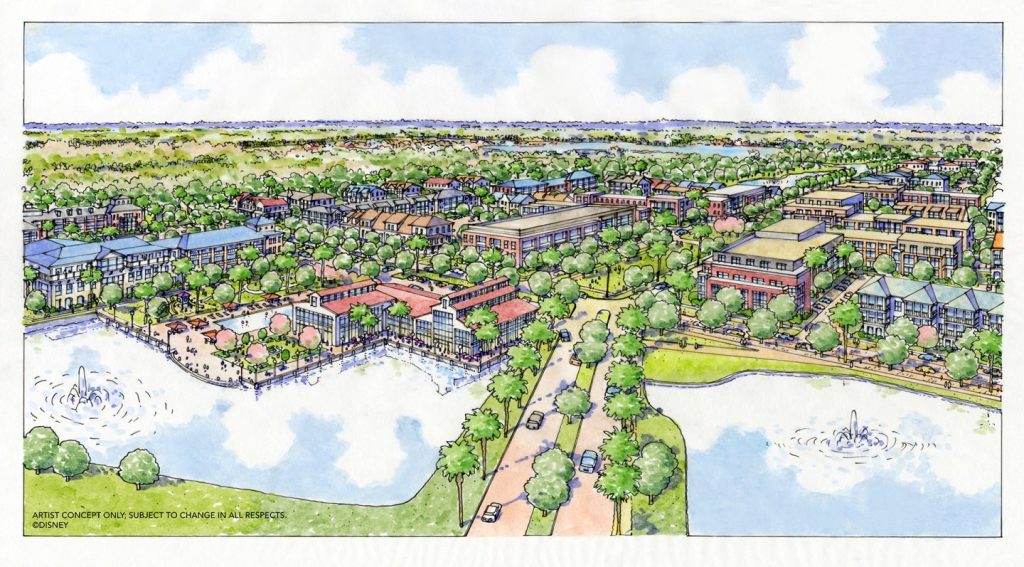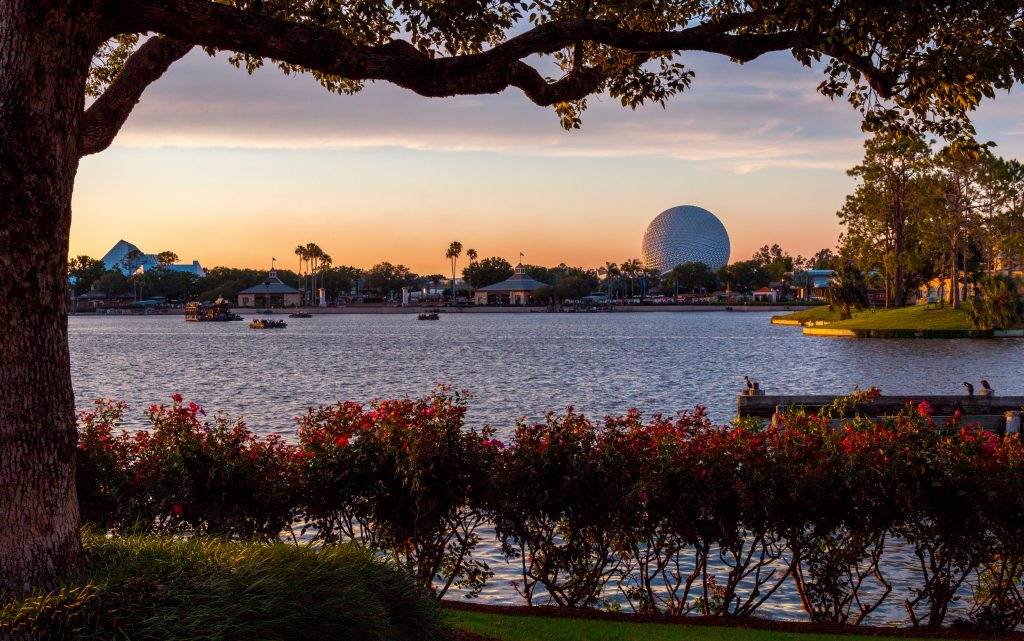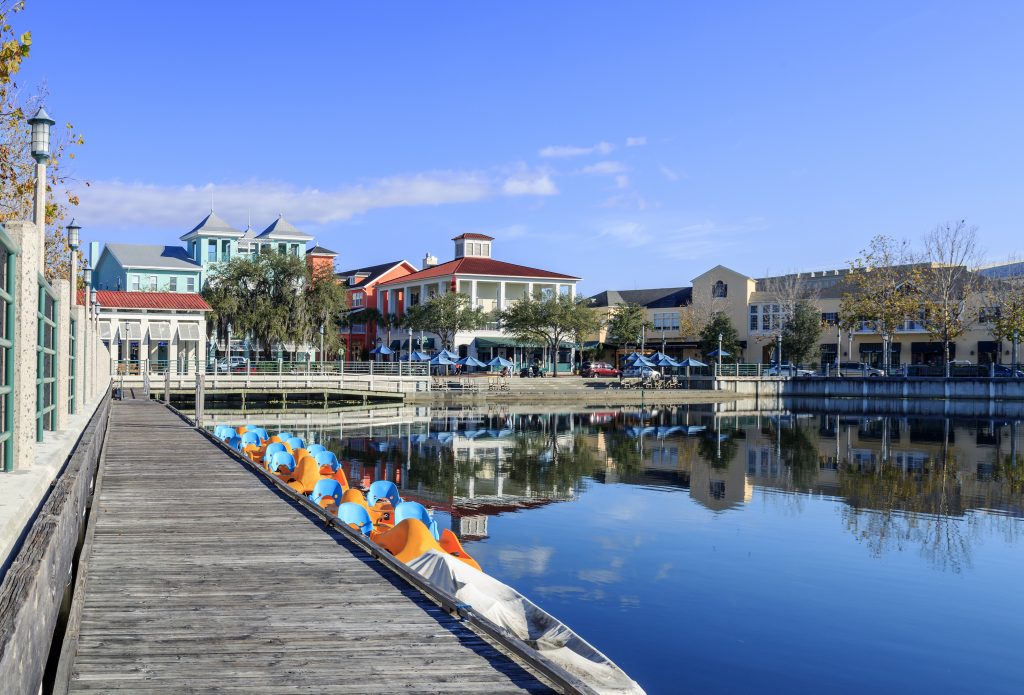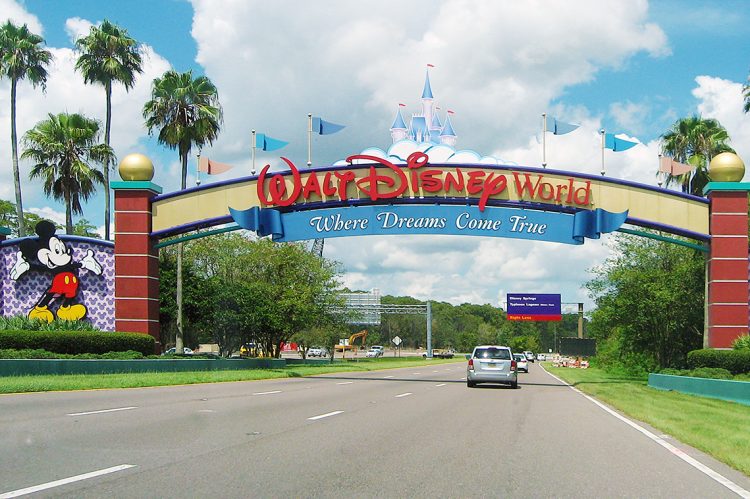Disney has always been well-known for its hospitality. Songs like, “Be Our Guest,” invite audiences to make a home for themselves—whether they’re visitors being delighted at the theme parks or families cozied up on the couch. Now, Disney hopes to repurpose its company commitment towards placemaking with a real estate venture sequel it hopes will have a better ending than its last.
In the first quarter of 2022 alone, the entertainment and media conglomerate has announced the development of two major residential community properties.
On April 6, the Walt Disney Company announced in a press release that it will be using 80 acres of land in Orange County, Florida to bring affordable housing opportunities to qualifying public applicants and its cast members (as Disney calls its employees). This development will expand on the initiatives it’s taken to address the nation’s affordable housing crisis—which also include several housing developments built around the Disneyland Resort.

In February, Disney also announced the launch of its new Storyliving by Disney communities, which will offer housing, entertainment and unique amenities encompassing a plot of land in Rancho Mirage, California—dubbed Cotino.

In collaboration with Scottsdale-based DMB Development specializing in planned communities, Cotino will allow homebuyers to purchase single-family homes, villa estates and condominiums, with some neighborhoods designated as 55+. Cast members will also manage day-to-day associations.
While Orange County remains in a concept phase, Storyliving in Rancho Mirage has been approved and will include a mixed-use district featuring shopping, dining and entertainment, a beachfront hotel and beach park with recreational water activities that can be accessed by the public through the purchase of a day pass.
Rancho REALTORS® have voiced their support for this endeavor, highlighting the power of influence communities like Cotino can have on a new era of homebuyers.
“There is an increasing market for lifestyle communities with conveniences—hotel, shops, restaurants—and easy access through walkability,” says Geoff McIntosh, broker associate for Coldwell Banker and former president of the California Association of REALTORS®. “Leave the car at home! We have a clientele—especially baby boomers and millennials—looking for exactly that.”
He adds that this development aims to deliver on its decades-plus mission of enchantment and enterprise.
“Leveraging the Disney brand is brilliant—with Disneyland opening in 1955 that brand is uniquely positioned to have broad appeal. Recognized as a “quality-trusted” brand with incredible Imagineering looks like a winning combination to me.”
The tagline on the Storyliving by Disney website reads, “Imagine. Create. Live your story.,” displaying illustrated, concept renderings of a diverse community backlit by a picturesque, desert-spring landscape. “A Living Painting,” another tagline suggests.
The notion of a suburban utopia conceived by Disney isn’t new. Many are familiar with Disney’s past residential endeavors—the most recent being the multi-million-dollar luxury properties in Golden Oak, Florida, located within Walt Disney World Resort, and its first and former residential model in Celebration, Florida.
The concept draws upon decades of achievements in innovation, brand loyalty…and quite a few learning-curves.
Something to Celebrate
In 1966, when Walt Disney outlined his vision for the Experimental Prototype Community of Tomorrow (EPCOT), it was less a suggestion for a compact representation of world heritage, but moreover an Arcadian Americana. Disney died a year later, and his grand vision metamorphosed into EPCOT park in 1982. In 1991, the company turned back the pages of his book and began planning an actualized version of Walt’s perfect town—climate-controlled bio-dome excluded.

Disney secured nearly 5,000 acres of land in Osceola County, Florida, a stone’s throw away from the parks, and in 1996, his vision was fully realized.
“Celebration” was a community styled off of the holistic design movement, New Urbanism, which aims to shift away from low-density zoning and single-use buildings and homes that became popular after the end of World War II.
New Urbanism promotes walkable, mixed-family neighborhoods, a centralized main street, accessible public spaces and a community model where function influences social well-being.
Disney hired celebrity architects around the world to design its residential and commercial infrastructure.
Celebration’s Town Center contained commerce, a town hall, a movie theater, schools and other civic establishments incorporated into the town. Homes were designed in different architectural styles like Classical, Victorian and Colonial Revival, with a front porch and garage in the back. Everything from street signs to storefronts, even manhole covers, were designed to tie the whole town together.
Postcard Perspective
When Kim Hawk first heard of Celebration, she was one of the first (of 5,000) people who showed up for the lottery Disney held for the sale of the first 350 homes.
“My mother, who was a broker at the time, said to me, ” Now’s the time to activate your life,” because it’s always smart when you can see a project from the ground up. I’ve been here for over 25 years since.”
Hawk, a REALTOR® for Florida in Motion Realty and reputed locally as the “Fairygodmother of Real Estate Near Disney,” shared what it was like at the start in terms of buyer expectations.
“There were people that put every bit of their energy into getting a house here,” she says. “Back in those days, it was required that you had to sell whatever property that you lived in prior because they wanted to have founding residents. All of a sudden, you really started to see the definition of supply and demand. The power of Disney behind the community really amped up the sales quickly.”
Hawk reveals that the community’s walkable streets, fiber optics and locale under a no-fly zone are still attractable assets.
“Because people are concerned about the pandemic returning, people have adopted this mindset of ‘who has the right resources where I can live the best lifestyle possible’,” she says. “I would say Celebration is skyrocketing because of that. Now, we’re getting calls from people who say, “I just want to live in Celebration, you don’t even have to show me the house.”

Social analyst and author Andrew Ross, who wrote about his year-long stint living in Celebration in his book, The Celebration Chronicles: Life, Liberty, and the Pursuit of Property Value in Disney’s New Town, resounded in favor of Celebration’s design scheme.
“The first people who came to Celebration were just dying to live on Disney land. You can compare Celebration with typical suburban subdivisions in Central Florida, but I think the quality of offering was far superior,” he details. “A master plan residential development wasn’t all that experimental at the time. However, when you think about the identity of the developer and that they were able to build a town center before people even moved in—that has never happened before in real estate history.”
Ross also has been vocal about the issue of affordable housing in American suburbs and rural areas, and cites Disney’s own shortcomings on the issue. His 2021 follow up to Celebration Chronicles titled Sunbelt Blues: The Failure of American Housing, provides even further insight into Disney’s response (or lack thereof) to the need for affordable housing within Celebration itself.
“At the time Celebration was built, the alternative was for the developer to put a bunch of money into a fund and have affordable housing built off-site, which is what they did,” he explains. “It was only $300,000—that doesn’t give you much affordable housing. As a result, there was nothing built-in in the way of permanent affordable housing in Celebration.”
The town remains to be a mixed-income community, but Ross articulates how once these kinds of properties become commercially successful, they no longer become affordable—which is what happened in Celebration and other New Urbanist-showpiece towns like it.
Hawk retrospectively addresses the issue of affordability in Celebration, saying, “It probably was a little bit of a stretch 25 years ago, but I think a lot of those people are now very happy with it because when they went to sell, they made a good amount of money from the properties.”
Because of its Disney name, critics couldn’t help but perceive Celebration as an extension of the theme parks—which complicated matters of public interest, according to Ross.
“The problem is, visitors and consumers of the theme parks are accustomed to a high level of customer satisfaction” he explains. “I think there were some people who expected that Disney would be on call if something went wrong and that they’d deliver customer satisfaction, but that doesn’t happen in real estate. You can’t control the speech of the residents in the same way you control animatronic figures in the theme park.”
Walt Versus Wall Street
Disney’s conflation of imagination and perception resulted in a fairytale-like dilemma. In truth, it was a real town, like any, with real problems.
Even though Celebration proved to be a commercial success for Disney in terms of home sales, the company sold Town Center in 2004 to Lexin Capital, a private-equity New York City firm.
Disney claimed that it wanted to focus on selling other commercial lands, but insisted it’d keep a watchful eye on the town for several more years. While Lexin assured that the effects on the town were going to be nothing short of a change in guard, the next decade plus proved otherwise.
The years following ignited a media frenzy. Crime, educational tussles and a litany of lawsuits from disgruntled residents plagued the town.
Hawk recounts how many residents wanted power to transfer over to its own residents who knew the town best.
“I was a member of a group of people that said we wanted to buy downtown versus Disney going out and selling it to a group that wasn’t familiar. I think if that had been the case, it might have been a better situation.”
She does maintain, however, that the issue involved both personal and public deception, since resolved.
“As far as expectations of what should be delivered, the town’s doing pretty well right now,” she holds. “My heart does go out to a couple people who had to fight in order to get the results that they wanted, but I wouldn’t say it was the town in its totality that was an issue.”
Celebration’s distinctive origins and design elements cement it as an entirely unique community, however, Ross addresses its drawbacks in a much broader context.
“There are communities all across America with a similar story to tell when they get taken over by private equity. They usually don’t go after fairly affluent places like Celebration, and they don’t usually get pushback (i.e. residents who fight back), but that’s what happened in Celebration.”
A New Chapter of Real Estate
Though Disney’s past real estate ventures do not necessarily dictate the future of Cotino, it certainly informs how they move forward. The narrative for Storyliving characterizes this project as an entirely new venture for Disney, and in many ways it is.
Since it is not the developer, it’s safe to assume that it would want to distance their brand more so than it has in the past.
Bringing his expertise in planned communities and Disney into the fold is DMB’s president and CEO, Brett Harrington, who formerly served as Celebration’s town manager in its formative years.
Though Rancho Mirage Mayor, Ted Weill, believes that Cotino will be a “fabulous fit” for the community and serve as a much-needed economic boost—he took the time to dispel some public concerns on the government website.
Its location has raised eyebrows. The state of California is experiencing a two-decade drought, and with plans to feature a 24-acre, “grand oasis,” lagoon on the property, many are wary of the environmental impact a structure like that will do. Disney safeguards the potential water shortage issues by stating they will be employing the use of Crystal Lagoons, which promotes sustainable, eco-friendly, low-consumption technologies.
Others question its location in relation to its nearest park. In contrast, Celebration is at arm’s length with Walt Disney World, and Golden Oak is located within the resort itself. Cotino does not have the luxury of such proximity (nearby Disneyland is two hours away).
Disney squares this by tying the land to the magic man himself, Walt Disney. The Coachella Valley was a beloved destination for Walt Disney and his wife Lillian, as well as other golden-age celebrities and U.S. presidents alike. It was a reprieve from the hustle and bustle of Hollywood, with Cotino offering a similar level of escapism.
Disney has yet to announce how much homes will cost, but it has stated that they will not be developing, building or selling the homes themselves. What is certain, however, is that REALTORS® up to the challenge of selling these homes will be marketing towards a very niche demographic who might welcome the idea of morning tee times, solitude in the Santa Ana’s and a community of like-minds with a penchant for theatrics.
David Cantwell, managing broker for Berkshire Hathaway HomeServices Bennion Deville Homes, offered a generally optimistic approach to this development, and revealed that the Disney connection was unbeknownst to city officials until the day before the official announcement came through.
“The response has been mostly positive,” he says. “It’s amazing was able to keep it quiet.”
Cantwell, whose corporate offices reside in Rancho Mirage, is encouraged that the city has put in place conservation efforts so that the water being taken from aquifers underneath the land and through its Colorado River reserves is mitigated through the use of the advanced tech being used to fill the lagoon.
“We have no thoughts on it going dry,” he maintains.
He also gave insight into the potential rate of these Cotino homes in lieu of an already steep market.
He noted that forces that have driven detached home prices higher, (i.e. low inventory and rising sales) continue to dominate the Coachella Valley housing market—currently averaging $630,000 for detached homes.
“Considering that the median price for homes have gone up over 40% in the Coachella Valley, we expect that the rate for these new properties will go for $500,000 or more, which is actually below the median in the area.”
As for who might be eying these homes, Cantwell categorized this target demographic as 55+ residents (the median age in Rancho Mirage is 65), Midwest and Pacific Northwest buyers who look for secondary homes in warmer climates and higher income families interested in the amenities being developed on the property.
In regard to its future community impact, Cantwell assures that this project can only bring out good things for the housing market.
“We need the inventory. A project of this size helps our market currently being affected by a low-cycle housing market. This property also offers plenty of room for growth in the commercial sector.”
Geoff McIntosh of Coldwell Banker additionally gave insight into the eventual process of selling these homes—and is hopeful that these properties would foster new leads and growth opportunities for area real estate agents.
“I would anticipate that there will be an onsite sales team that handles the initial sell out. Given the size and scope of the project it will likely take years,” McIntosh estimates.
“Generally, new developments are very welcoming of the local real estate community as we are influential in introducing prospective buyers to all the options they have in the area. Usually the onsite sales office represents both the developer and the new home buyers received through referrals by local REALTORS®.”
Though many are wary of this property’s large footprint negatively impacting the landscape, McIntosh trusts the experts and the bottom-line overview as compared to similar properties in the area.
“I believe adequate studies have been completed to address these concerns and the location of the project is 618 acres of undeveloped desert land on the north side of most of the improved property in Rancho Mirage. In comparison, Del Webb Rancho Mirage is on a site about half the size with roughly 1,050 planned homes at completion. There are only 1932 residences and a 400-room boutique hotel on site at Cotino, so it will be relatively low density.”
In a continued market that favors the seller, Judy Ziegler of Bennion Deville Homes contends that agents have the leg up. Compared to years past when the area really catered to secondary homes, work-from-home opportunities and an emphasis on life-work balance has made the greater Palm Springs area and alfresco living desirable year-round.
“COVID changed our entire market. People are staying here,” she says.
A project of this scale naturally invites some curiosity and criticism. It’s safe to say onlookers will be tuning into every phase of this venture—from the very first nail to the cutting of the ribbon.
Storyliving seeks to expand on the concept of storytelling set out by Walt himself nearly a century ago wherein everyday is the story, and you hold the pen.
There is hope, however, that these communities foster a new chapter of real estate beyond just its whimsicalities and brand name. These undertakings illuminate the desire and necessity for a larger scope of natural and accessible living spaces throughout the country.
Whether Disney will be the one to change the status quo of real estate, only time will tell.
Joey Macari is RISMedia’s associate editor. Email her your real estate news ideas at jmacari@rismedia.com.












